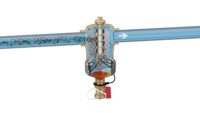The first time I ever bid and landed a commercial plumbing contractor, it was for a huge retail store on the upper floor of a local shopping mall. Every bidder was required to provide submittals for virtually everything being installed. Six copies, if you please, and even if you don’t! I couldn’t understand why, if I am sticking to the products specified, do I need to waste time, paper and ink. After filing the required submittals with the architect, we waited for engineer-stamped approvals — or rejections if we deviated from specifications.
A hole in one
After core-drilling the concrete floor for our toilet, drainage, mop sink, and water line risers, we covered every opening with wood that had the appropriately sized plug — attached with screws – to prevent any objects from falling into the lower floor store’s retail space. We cleaned up all of our construction debris daily, but other subcontractors often left all debris behind. The general contractor sent in a cleaning crew one night after all tradespeople were gone for the day, to clean up the mess. Unfortunately, they assumed our wooden covers were part of the mess and threw them in the site dumpster. They then began pushing and sweeping up all the debris and discovered it was easier to push/sweep debris into our core-drilled toilet drain openings! Unfortunately, that concluded with a ceiling suspended ceiling tile collapsing down onto several customers and let’s just say the following day’s morning safety meeting was a bit loud!
As the work progressed, and job site inspections by the architect and the PE (plumbing engineer) passed, they began to trust us and became very cordial. More than halfway through the project, the out-of-town HVAC contractor ended up being fired and they asked me if we could complete the remaining work. Locating the 3M Fire Barrier duct wrap that met the listed specifications became a slight challenge, but the internet to the rescue, and sourcing the best price was a bit tricky. I had to scrutinize the listed product details to ensure they matched not only the specification’s fire rating, but the overall length in order to make sure we weren’t being hoodwinked by shorter or narrower duct wrap.
Danger — watch out for flooring loads!
It seemed like everyone on site had either an articulating boom or scissors lift. The architect determined that no two lifts should be within 30 feet of each other, which meant coordinating work with the other trades. Given that the job was on an upper floor of the mall, that seemed like a common sense notion.
As always is the case, as the job nears completion, the pace of work becomes hectic and virtually all trades are on site, seemingly working on top of one another! Tempers fray, and the general contractor becomes the game-day referee. This is when the reward for having developed a really good working relationship with the general contractor pays off.
Submittals don’t account for much if no one is checking on the installer’s work and they cheat.
The Grand Opening!
The day has finally arrived to throw open the doors to the public and it turned out to be a very popular establishment. Of course, the sewer backed up and naturally, the access to the lower floor cleanout – located in a not yet developed area — required getting security to give us access. Someone had flushed a used disposable diaper! The fountain of raw sewage was, however, very impressive when we first removed the cleanout plug.
But bigger surprises were lurking. Submittals don’t account for much if no one is checking on the installer’s work and they cheat. We received a panicked phone call a few days later telling us the HVAC system was on lockdown. No air conditioning on a hot August day when the outdoor ambient air temperature and humidity are Siamese twins equals customers flocking elsewhere! Access to the roof also involves security to unlock the padlock on the roof hatch. Then it’s a long walk while utilizing ladders to cross over to other roofs that are not at the same height. It turned out the installer had gone rogue by installing smoke duct detectors that were not compatible with the remote monitoring system and that had triggered a fault tripping the safety, which automatically locked down the multiple rooftop units.
Cell phones provided the ability to communicate freely to our inside crew who were working with the store manager who was also on his cell phone talking to corporate headquarters. We were able to bypass the smoke duct detectors until the correct compatible specification-compliant models could be obtained via next-day-air and installed the same day. That also required we coordinate with both the mall management and the local fire department to seek approval. We also discovered the HVAC installer had skipped the automatic enthalpy motorized dampers and instead of the 2-inch thick pleated air filters specified, had installed 1-inch standard throwaway MERV 4 filters. As we would discover in the weeks that followed, the HVAC installer had not properly sealed the roof curbs and rainwater was able to infiltrate and leak through to the retail space below. Best guess on my part was accessing the roof area to check on the HVAC installation was not performed, most likely due to the difficulty of getting to the work area. All of this occurred before any retainage was released to subcontractors, so best guess is they withheld monies owed (in theory) to the HVAC contractor to pay us for the work required to both complete their work, replace the smoke duct detectors, rewire the controls, and seal the roof curbs.
Lesson learned
Submittals do matter, but only if someone in a position of authority is ensuring compliance. They are not a waste of time, paper, and ink! Poor workmanship, or deliberate corner-cutting, like skipping the time and material to seal those multiple HVAC roof curbs, is harder, if not virtually impossible, to catch unless the person inspecting the installer’s work is specifically looking for sealant, but that’s where retainage and a required warranty period can be worth their weight in gold.




